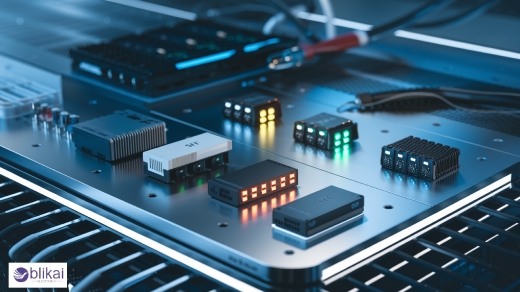Top Transceivers for High-Speed Data Transmission [Ultimate Guide]
What Are Transceivers?
A transceiver, which is a short form for a combination between transmitter and receiver, is an electronic apparatus. This apparatus is capable of sending and also receiving data, these functions are crucial for a number of emerging communication systems, which is why it's their core component. Understandably, they are specially built to turn the data from one form to another, from the transition from electrical signals to optical ones and back, thereby establishing the possibility of long-distance data transfer.

Basic Operation of Transceivers
One of the key aspects of a transceiver functioning is the following two processes:
- Transmission: A transceiver gets the incoming data and encodes the data into a suitable format and then it is sent as a signal to an external end.
- Reception: Where the device takes up signals coming from outside, decodes these signals and then changes them into data that can be used out.
Key Components of Transceivers
Transmitter
The transmitter is the soul of a transceiver, and its responsibility is to change electrical signals into a format that can be transmitted over a communication medium. It usually consists of a modulator that adds a signal to the data and a power amplifier that makes the signal strength bigger. More sophisticated transmitters might include digital signal processing (DSP) capabilities that will enhance the smoothness as well as the efficiency of the transmission.
Receiver
Simultaneously, the receiver catches moving signals and presents them in a reusable form in cooperation with the transmitter. The necessary components of a receiver consist of an antenna to see the signal, a low-noise amplifier to make otherwise undetectable signals stronger, and a demodulator to extract the original from the carrier wave. State-of-the-art receivers often use complex filter technologies to cut down the noise effect and enhance signal quality.
Antenna
It is the antenna that links the transceiver and the transmission medium and so performs the function of the interface. It changes the electric signals to electromagnetic waves in the process of transmission, and contrarily, it changes electromagnetic waves back to electrical signals for a receiver. Antenna designs vary according to the frequency range up to the requirements, with a dipole array as the simplest and the phased array having the choice for high directivity and gain, which is more complex.
Circulator or Duplexer
When the system's functionality is about simultaneous transmission and reception, a circulator or duplexer is an essential thing that serves the need in a way that both paths are used. Transmit or receive paths need to be isolated to prevent interference between signals and to guarantee smooth operation.
Common Applications of Transceivers
Telecommunications Networks
Telecommunication networks operate entirely at their best with transceivers which aid in the smooth transmission of data over long distances among various points. In cellular networks, the transceivers are among the key parts of the base stations that create a communication channel between the mobile devices and the core network. They ensure the reception and transmission of voice calls, text messages, and high-speed data for internet browsing and streaming services.
Fiber Optic Communications
A unique application of the transceivers in fiber optic networks is that the transceivers can change electrical signals to optical signals and vice versa. This particular application is mainly used in longer data transmission over the oceans, for instance. Fiber optic transceivers make possible highly effective, low-period connections, which is why data centers and enterprise networks are mainly using them.
Wireless Local Area Networks (WLANs)
Transceivers are the foundation of a Wi-Fi network, where the routers connect with the devices wirelessly. They also make possible the process of packets being sent and received, which in turn enables users to access the internet and transfer information without using cables.
Satellite Communications
The use of transceivers is the primary way of communication between satellites and GPS and between the base stations and the satellites when it comes to satellite communication systems. This use is very crucial for global positioning systems (GPS), satellite television, as well as for long-distance communication in the rural area where terrestrial networks are absent.
Key Features to Look for in High-Speed Transceivers
Data Rate and Bandwidth
The most important feature to look for in high-speed transceivers is the data rate and bandwidth. Higher data rates enable rapid information transmission, while more bandwidth enables data to be handled with higher and higher volumes. Search for transceivers that may include the latest 100G, 400G, or even 800G in case you have particular requirements.
Signal Integrity and Error Correction
One of the main reasons why the transmitters or receivers may not work is due to signal integrity problems. By using state-of-the-art techniques of error correction like Forward Error Correction (FEC), the transceiver can lower the number of information losses and, at the same time, ensure that the data goes to the proper location. For instance, Clock and Data Recovery (CDR) can be added as one of the procedures for maintaining signal quality over long distances.
Power Efficiency
Power consumption is an essential factor as both data centers and networks try to attain higher energy efficiency. You should focus on acquiring a transceiver that has a low power consumption rate but, at the same time, works efficiently. In contrast, the technologically, much more advanced, innovative transceivers involve various intelligent functions of power management that adjust power usage.
Form Factor and Compatibility
Transceivers' physical dimensions and compatibility are significant issues, particularly in the case of space-limited locations. The most common form factors are SFP, QSFP, and OSFP. Do your assignment to see to it the transceiver you choose gets on well with your current network infrastructure and supports the necessary protocols and interfaces.

Top Transceivers for High-Speed Data Transmission
Cisco SFP-10G-SR
In high-speed data transmission, Cisco's transceiver SFP-10G-SR is a standout among the best. This is the small form-factor pluggable (SFP+) module that provides a 10GbE connection in a way that is fast and ideal for data centers and enterprise networks. The optical nature of this module, which can go as far as 300m over multimode fiber, allows the whole scale of installations.
Finisar FTLX8574D3BCL
The Finisar FTLX8574D3BCL showed promising development in the high-speed data transmission area. This SFP+ type of transceiver operates 10GBASE-SR/SW connections reliably, thus ensuring a good transmission speed. It not only supplies low power consumption but is also compatible with the primary network equipment producers, a feature that makes it a favorite of IT experts across the globe.
Intel E10GSFPSR
Intel E10GSFPSR is the most effective 10 Gigabit Ethernet solution with a testing speed of 10G. This SR (short-range) module provides the signal quality needed for low latency and, thus, is an essential element for data centers that handle high-powered work. Its functionality is in partnership with Intel Ethernet Network Adapters, ensuring the use of an inexpensive infrastructure.
Mellanox MMA1L10-CR
The Mellanox MMA1L10-CR is a highly sought-after transceiver promising cutting-edge performance by delivering impressive 100 Gbps speeds. The QSFP28 module is an excellent choice for data center interconnects and high-performance computing applications that require ultra-high bandwidth. The speed and reliability of this device are so advanced that the most demanding customers will consistently prefer it.
Advantages of Using High-Quality Transceivers
Improved Data Transmission Speeds
100Mbps can increase the data rate over the air by using high-quality transceivers such as those supplied by Cute, and dependable signal transmission can be obtained. This, in turn, improves the way data is delivered from one device to another. The said parts are capable of handling a higher bandwidth and, consequently, a lower latency, which manifests in the workability of the system as a whole.
Enhanced Signal Integrity
The performance of signal communication depends on many aspects, such as the quality of transceivers. High-quality transceivers are the best option as they not only have a wider bandwidth but also cause the lowest latency. They are an excellent gift for you when you need them badly.
Greater Energy Efficiency
High-quality transceivers often incorporate state-of-the-art power management features. These components are designed to optimize power consumption without compromising performance. By reducing energy waste, they not only lower operational costs but also contribute to more environmentally friendly and sustainable network infrastructures.
Increased Reliability and Durability
Besides a streamlined approach to enjoying life, you will be able to get satisfaction only if you use high-quality transceivers. In order to be in the best possible condition, lovely and super-fly transceivers will turn down the wave pulse at the receiver's station smoothly without causing any noise.
Conclusion
High-speed transceivers are fundamental to the data transmission system. They make communication more efficient in various applications. This comprehensive guide goes from defining the key components and types of transceivers to the most common applications and features, thus giving an all-inclusive overview of these essential devices. We have emphasized the best-performing transceivers for high-speed data transmission and considered the benefits of employing top models.
Related Articles
Basic Knowledge of Electronic Parts:Complete Guide
Top 10 Common Electronic Components Guide
Exploring Electronic Components - Their Varieties, Roles, and Future Directions
Impact of IRF3205 MOSFET on Power Electronics: Advancements and Applications
2N3904S Transistor: Features, Applications, and Datasheet
BSN254A Transistor: Applications, Datasheet, and Equivalent
TPSM82823ASILR: Applications, Datasheet and Features
UCC5310MCDR: Applications, Datasheet and Features
TCAN330GDCNR: Applications, Datasheet and Features
ISO7321CDR: Applications, Features and Datasheet
2N4401 NPN Transistor: Datasheet, Applications, and Features
8255 Microprocessor:Structure, Principle & Its Applications
D882 Transistor: Understanding Its Functionality
C1815 Transistor: What You Need to Know?










